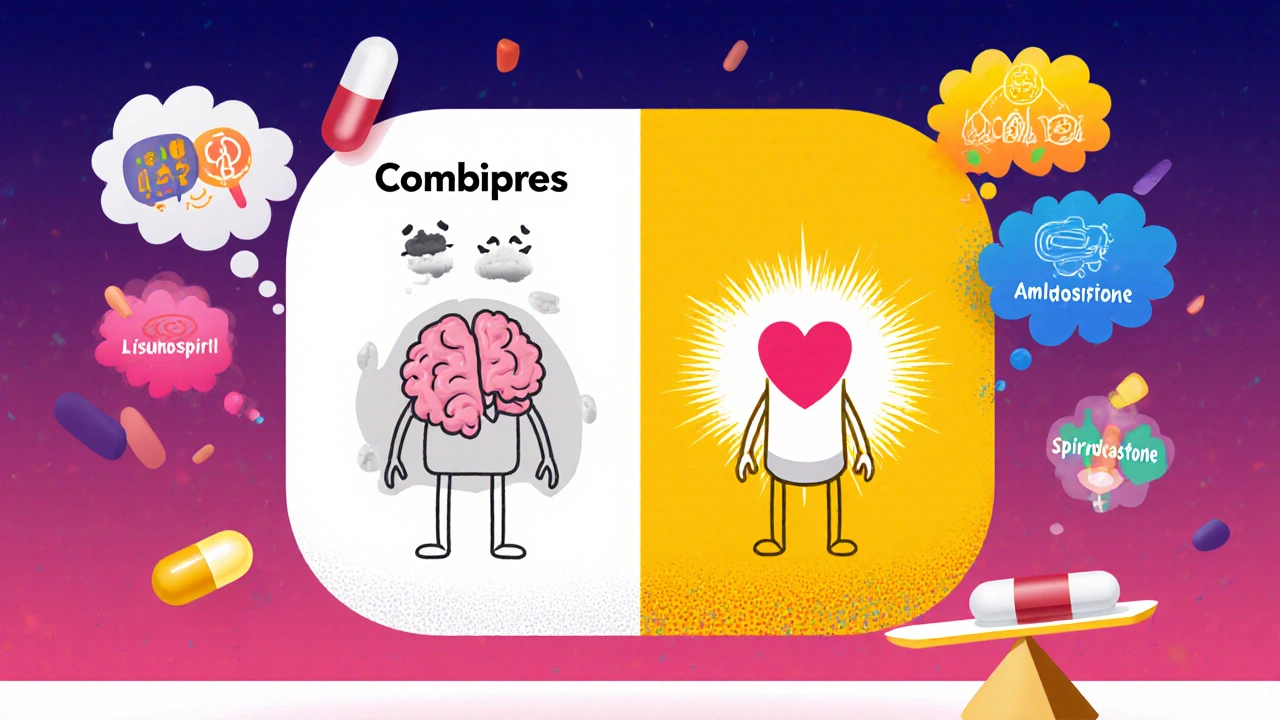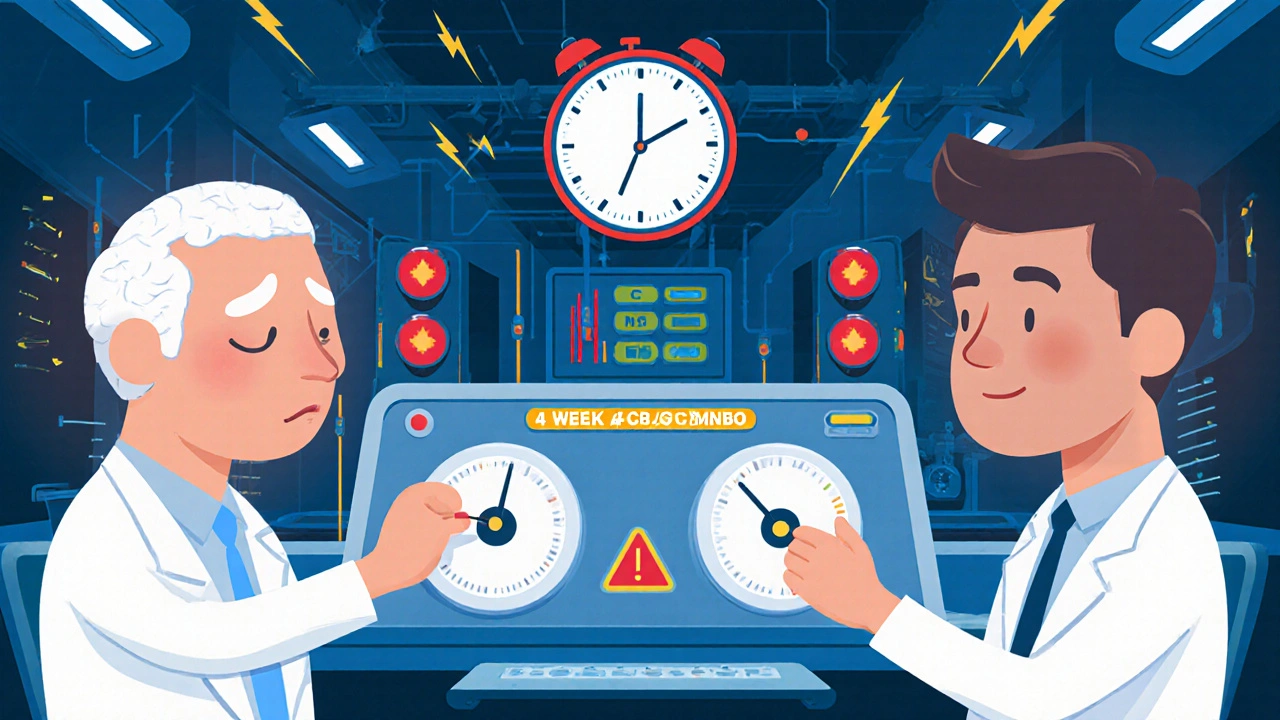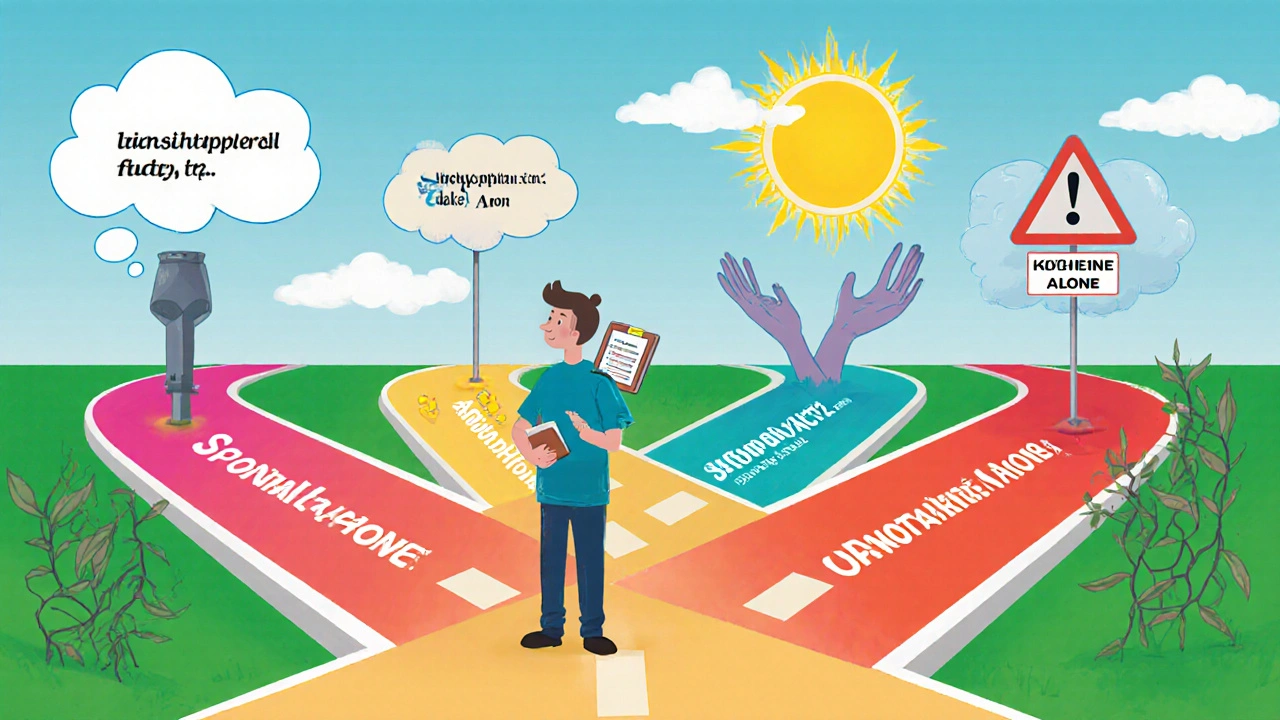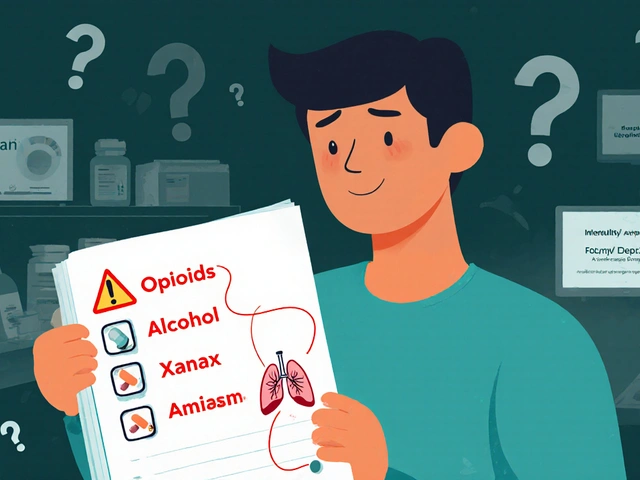 28
Oct,2025
28
Oct,2025
Combipres is a combination pill used to treat high blood pressure. It contains two active ingredients: chlorthalidone, a thiazide-like diuretic, and clonidine hydrochloride, a centrally acting alpha-2 agonist. Together, they work to lower blood pressure by reducing fluid volume and calming overactive nerve signals that tighten blood vessels. But Combipres isn’t the only option. Many people end up switching because of side effects, cost, or lack of effectiveness. So what else is out there? And how do those alternatives stack up?
How Combipres Actually Works
Combipres combines two different mechanisms. Chlorthalidone helps your kidneys flush out extra salt and water. That reduces the volume of blood flowing through your vessels, lowering pressure. Clonidine works in your brain-it tells your nervous system to slow down signals that make your heart beat faster and your blood vessels squeeze tighter. The combo can be powerful, especially for people whose blood pressure doesn’t budge with one drug alone.
But here’s the catch: because it hits two systems at once, side effects can pile up. Common ones include dizziness, dry mouth, fatigue, constipation, and low potassium. Some people feel so sluggish they can’t drive or work. Others get rebound high blood pressure if they skip a dose. That’s why many patients and doctors look for alternatives.
Common Alternatives to Combipres
There are dozens of blood pressure meds. But not all are equal when you’re trying to replace Combipres. The best alternatives match its dual-action approach or offer similar results without the same side effects.
1. Lisinopril + Hydrochlorothiazide (Prinzide, Zestoretic)
This combo is one of the most popular replacements. Lisinopril is an ACE inhibitor that relaxes blood vessels by blocking a hormone called angiotensin II. Hydrochlorothiazide is a milder diuretic than chlorthalidone but still effective. Together, they lower blood pressure without touching the central nervous system like clonidine does.
Studies show ACE inhibitors like lisinopril reduce heart attack and stroke risk more than older diuretics alone. Side effects? Less drowsiness, no dry mouth, and no rebound spikes. The big downside? A dry cough in about 10-20% of users. If you’re prone to coughing, this might not be the pick.
2. Amlodipine + Olmesartan (Benicar HCT, Azor)
This combo uses a calcium channel blocker (amlodipine) and an ARB (olmesartan). Amlodipine opens up arteries by relaxing muscle in their walls. Olmesartan blocks the same hormone as lisinopril but works differently-so it’s less likely to cause a cough. This combo is great for people who need strong, all-day pressure control without sedation.
People on this combo rarely report fatigue or dizziness. Weight gain and swelling in the ankles are possible with amlodipine, but it’s usually mild. This is often the go-to for older adults or those with diabetes because it’s gentle on kidneys and doesn’t mess with electrolytes like chlorthalidone can.
3. Metoprolol + Hydrochlorothiazide (Lopressor HCT, Toprol-XL HCT)
Metoprolol is a beta-blocker. It slows your heart rate and reduces how hard your heart pumps. Paired with hydrochlorothiazide, it’s a classic combo used for decades. It’s cheaper than newer options and works well for people with high heart rates or anxiety-related spikes in blood pressure.
But beta-blockers can cause tiredness, cold hands, and in some cases, worsen asthma or depression. They’re not ideal for people with diabetes because they can hide low blood sugar symptoms. Still, for someone who needs heart rate control along with pressure control, this combo makes sense.
4. Spironolactone (Aldactone) as a Standalone or Add-On
Spironolactone is a potassium-sparing diuretic. Unlike chlorthalidone, it doesn’t drain potassium-it actually helps keep it. That’s a big plus if you’ve had low potassium from Combipres. It’s often added to other meds when blood pressure still won’t budge, especially in resistant hypertension.
Side effects? Men might get breast tenderness or reduced libido. Women may notice irregular periods or increased hair growth. But for many, especially those with fluid retention or heart failure, it’s a game-changer. It’s not a direct replacement for clonidine, but it can replace the diuretic part of Combipres without the CNS side effects.
5. Clonidine Alone (Catapres) or Clonidine Patch
Some people only need the clonidine part of Combipres. If your blood pressure is high because of nervous system overdrive-like in stress-induced hypertension-clonidine alone might be enough. The patch (Catapres-TTS) gives steady release over 7 days, so you don’t have to remember pills twice a day.
But clonidine alone still causes drowsiness, dry mouth, and rebound hypertension if stopped suddenly. It’s not usually a first-line choice anymore, but for people who respond well to it and can manage the side effects, it’s a viable option.
Comparison Table: Combipres vs. Top Alternatives
| Medication | Primary Mechanism | Side Effects | Best For | Drawbacks |
|---|---|---|---|---|
| Combipres | Diuretic + Central alpha-2 agonist | Drowsiness, dry mouth, constipation, rebound hypertension | Severe or resistant hypertension, patients with high sympathetic tone | High risk of fatigue, not ideal for daily driving or mental focus tasks |
| Lisinopril + HCTZ | ACE inhibitor + Diuretic | Dry cough, dizziness, high potassium | Patients with diabetes, kidney protection needed | Cough can be persistent; not for people with ACE inhibitor sensitivity |
| Amlodipine + Olmesartan | Calcium blocker + ARB | Ankle swelling, flushing, dizziness | Older adults, those with stable heart rhythm, no cough history | Swelling can be bothersome; may need dose adjustment |
| Metoprolol + HCTZ | Beta-blocker + Diuretic | Fatigue, cold extremities, masking hypoglycemia | High heart rate, anxiety, post-heart attack | Not good for asthma, depression, or diabetics |
| Spironolactone | Potassium-sparing diuretic | Breast tenderness (men), irregular periods (women), high potassium | Resistant hypertension, fluid retention, low potassium from other diuretics | Slow to work; hormonal side effects limit long-term use |
| Clonidine (alone) | Central alpha-2 agonist | Drowsiness, dry mouth, rebound hypertension | Stress-related spikes, short-term use, patch for compliance | Not for long-term monotherapy; withdrawal risks |

When to Consider Switching from Combipres
You don’t need to switch just because a new drug came out. But if any of these apply, it’s worth talking to your doctor:
- You feel too tired to get through the day
- You’re dizzy when standing up or driving
- Your blood pressure still reads above 140/90 after 3 months
- You’ve had low potassium levels more than once
- You can’t afford the brand or generic version
- You’re trying to get pregnant or are breastfeeding
For example, a 62-year-old man in Melbourne was on Combipres for 2 years. He’d get so sleepy after lunch he’d nap at his desk. His BP was controlled, but his quality of life dropped. He switched to amlodipine + olmesartan. Within 3 weeks, his energy returned, his BP stayed under 130/80, and he stopped needing afternoon naps.
What Doctors Look for When Choosing Alternatives
It’s not just about lowering numbers. Doctors consider your full health picture:
- Age: Older adults often do better with calcium channel blockers or ARBs.
- Diabetes or kidney disease: ACE inhibitors or ARBs are preferred-they protect kidney function.
- Heart issues: Beta-blockers or spironolactone help after heart attacks or in heart failure.
- Other meds: Some drugs interact with clonidine or chlorthalidone. Your pharmacist can flag these.
- Lifestyle: If you drive for work or operate machinery, sedating drugs like clonidine are risky.
There’s no one-size-fits-all. That’s why your doctor might try one alternative, wait 4-6 weeks, then try another if it doesn’t stick.

Cost and Availability in Australia
In Australia, Combipres is available as a generic. The cost is around $15-$20 per month with a PBS subsidy. Most alternatives are also subsidized:
- Lisinopril + HCTZ: $7-$12/month
- Amlodipine + Olmesartan: $12-$18/month
- Metoprolol + HCTZ: $8-$14/month
- Spironolactone: $5-$10/month
Clonidine alone is cheaper than Combipres, but you’d need to buy two prescriptions instead of one. That can add up in co-pays and pharmacy trips.
Insurance coverage varies. Always check with your pharmacist before switching-sometimes a different brand or combo is covered better.
What Happens If You Stop Combipres Suddenly?
This is critical. Clonidine doesn’t just lower blood pressure-it keeps your nervous system calm. If you stop it cold turkey, your body goes into overdrive. Blood pressure can spike dangerously high within hours. Heart rate can race. You might get headaches, nausea, or even a stroke or heart attack.
Always taper off clonidine under medical supervision. Your doctor will likely reduce the dose slowly over 2-4 weeks. Never stop on your own, even if you feel fine.
Next Steps: What to Do Now
If you’re on Combipres and unhappy:
- Track your blood pressure at home for a week. Note times, symptoms, and readings.
- Write down every side effect you’ve had-even small ones like dry mouth or constipation.
- Check your current cost and PBS subsidy status with your pharmacist.
- Book a consultation with your GP or cardiologist. Bring your log.
- Ask: "Is there a better option for my lifestyle and health goals?"
Many people switch and feel like they got their life back. It’s not about giving up on Combipres-it’s about finding what fits you best.
Is Combipres still commonly prescribed today?
Combipres is still prescribed, but less often than in the past. Most guidelines now recommend starting with ACE inhibitors, ARBs, calcium channel blockers, or thiazide diuretics alone before adding a second drug. Combipres is usually reserved for patients who haven’t responded to single agents or who have high sympathetic nervous system activity. It’s not a first-line choice anymore.
Can I take Combipres with other blood pressure meds?
It’s possible, but risky. Combipres already combines two drugs. Adding a third increases the chance of low blood pressure, dizziness, or kidney issues. Doctors rarely add more unless it’s for resistant hypertension-and even then, they usually replace Combipres instead of stacking on top of it.
Does chlorthalidone cause more side effects than hydrochlorothiazide?
Yes. Chlorthalidone is longer-acting and more potent than hydrochlorothiazide. It can cause more electrolyte imbalances, especially low potassium and sodium. It also has a higher risk of dehydration. That’s why many doctors now prefer hydrochlorothiazide for milder cases or when combined with other drugs.
Are there natural alternatives to Combipres?
No natural supplement can replace Combipres. Some, like garlic extract, beetroot juice, or magnesium, may help lower blood pressure slightly-but not enough to treat moderate to severe hypertension. Relying on them instead of prescribed meds can be dangerous. Lifestyle changes (salt reduction, exercise, weight loss) can support medication, but they don’t replace it.
How long does it take for a blood pressure med to start working?
Most blood pressure meds take 2-4 weeks to reach full effect. Diuretics like chlorthalidone can show results in a few days, but clonidine and ACE inhibitors take longer. Don’t judge effectiveness after just a week. Give it time, track your numbers, and follow up with your doctor at the 4-week mark.






Combipres made me feel like a zombie on a Monday morning 🥱. I was driving to work and nearly missed my exit because I couldn’t stay awake. Switched to amlodipine + olmesartan and suddenly I’m human again. No more afternoon naps, no dry mouth, just chill vibes and normal BP. Why do doctors still push this thing? 🤷♂️
Spironolactone is underrated. I had low K+ on chlorthalidone for 3 years. Switched to spiro + losartan - K+ stabilized, BP better, no drowsiness. Only downside? My wife says I’m moody. Maybe it’s the pills, maybe it’s the kids.
People talk about meds like they’re some kind of magic potion but really we’re just chemically tampering with our nervous systems because we refuse to live simpler lives. Eat real food. Walk more. Breathe. Stop outsourcing your health to Big Pharma. Combipres? More like Combi-Depression. Clonidine is just a chemical sigh. We used to endure life without pills. Now we just medicate the silence.
Just wanted to say thank you for this breakdown - I’ve been on Combipres for 18 months and felt so alone in my frustration. The dizziness and fatigue were wrecking my yoga practice and my job. I took your table to my doctor and we switched me to amlodipine + olmesartan. Two weeks in and I’m sleeping through the night for the first time in years. I’m not just healthier - I’m me again. You guys are the real MVPs.
Anyone else notice how everyone’s switching to ARBs and CCBs but no one talks about the fact that clonidine was originally developed as a nasal decongestant? Yeah, you read that right. It was meant to unclog your nose, not calm your nervous system. The fact that we’re still using it as a BP drug is wild. We’re basically giving people a decongestant to fix stress-induced hypertension. That’s like using a bandaid on a broken leg.
My dad was on Combipres for 5 years. He’d forget his keys, his glasses, sometimes even my name. We thought it was aging - turns out it was the clonidine. Switched him to lisinopril + HCTZ and within 3 weeks he was back to telling his terrible jokes and fixing the sink. I’m so glad we found this info. It’s not just about numbers - it’s about being present in your own life.
Thank you for the thorough and compassionate overview. This is exactly the kind of information patients need - not just clinical data, but real-life impact. The note about tapering clonidine is critical. Too many people stop cold turkey because they feel fine, not realizing the danger. This post could save lives.